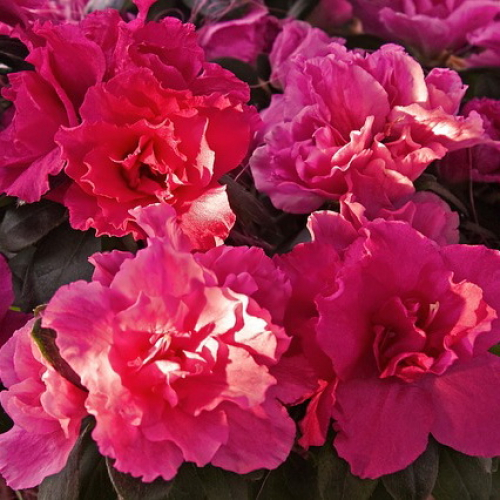Indoor plants Azalea

Description
Characteristic Features of Azaleas
Azalea is a group of plant species that were previously classified into a separate genus in the heather family Ericaceae and are now part of the genus Rhododendron in the same family. The genus is very extensive and comprises about 800 species of shrubs and trees. Azalea earned the love of thousands of plant enthusiasts by its magnificent showing of flowers. It is a dwarf shrub just 30-50 centimetres tall, so the Aborigines in a famous song by Vladimir Vysotsky could not actually be sitting under it in a circle and eating one another from dawn till night.
Many varieties of potted Azaleas are common and well-known. All or almost all of them are derived from two specific species (mostly, the first of them):
- Rhododendron simsii, commonly known as Sims's Azalea or Indian Azalea.
- Rhododendron obtusum, commonly known as Hiryu Azalea or Kurume Azalea.
Azalea's charming flowers are not large but very profuse and long blooming (from November to May). You need to know that the weaker the blooming it, the more luxuriant the shrub is.
The Secrets to Successfully Growing Azaleas
It is clear from the information above that timely pruning is essential. Begin it in May, after flowering. Remove the following shoots (especially those growing towards the centre of the plant):
- All weak shoots,
- All overgrown shoots,
- All shoots that ceased blossoming,
- Small and young shoots emerging close to the buds.
Make sure to pinch back new growth that has not been removed, leaving 4 to 6 leaves on each shoot. If you want to have more buds, remove the tips throughout the year. Pruning can be combined with repotting (see below).
Below are other factors that can ensure a long flowering period and best growth of your Azalea:
a) Water thoroughly every other day in the growing period from March to September. Water even more frequently and thoroughly during flowering.
b) Relatively low temperature. Temperatures of 18-21 ° C in the summer and 11-15 ° in the winter are best.
c) The required air humidity is provided by frequent misting of the plant. During flowering, reduce frequency or even completely stop misting.
d) Light must be bright enough. Place your Azalea in a brightly lit room where it is never in direct sunlight.
d) Feeding with compound fertilizer (with no chlorine!) every 2-3 weeks in the spring and summer. During budding, feed twice with a superphosphate solution (15 grams per 10 litres of chlorine-free water).
Repot the plant once in 2-3 years after flowering. The exotic Azalea loves acidic soil, in contrast to many houseplants. It is best to use heath soil, although it is less fertile compared to the leaf mold. If no heath soil is available, you can use a mixture of coniferous forest soil and peat at 2:1, adding some fine clean river sand. As the Azalea's root system is shallow and tender, only use shallow pots (wide and low), and repot the plant carefully without damaging the roots.
Azaleas can be propagated from May or June to August by semilignified tip cuttings. Plant them in the coniferous soil (or coniferous soil mixed with peat and river sand) and cover with glass or transparent plastic. Mist regularly to ensure constant high humidity (at least 80%). Watering should be regular, too. The temperature should be maintained at around 25 ° C. If all the conditions are met, the cuttings will root in about two months.
Potential Problems
Diseases are caused, as a rule, by mistakes in care.
Leaf shrivelling and drop indicate insufficient watering.
Leaves may drop without shrivelling. This is a sign of waterlogged soil.
If flowering ends quickly, the humidity is too low.
Major pests:
- Red spider mite (Tetranychus cinnabarinus) feed on cell sap causing leaves to lose colour and turn grey and later brown.
- Aphids also feed on plant sap. They are more dangerous because they produce a sweet substance called honeydew which can lead to a black sticky surface growth called sooty mold (Capnopodium).
Be careful and sensible! With the right care, Azalea brings lots of joy into your life.







 305
305







